Ethical Decision-Making in Business: The Case of Marcos' Injury
VerifiedAdded on 2020/05/16
|11
|2790
|57
Essay
AI Summary
This essay evaluates the potential legal negligence claims against an outdoor adventure company following an incident where Marcos was injured due to a lack of proper harness safety measures. The analysis will focus on whether there is a duty of care owed by the company, if this duty was breached, and if that breach directly caused Marcos's injuries resulting in damages. Furthermore, ethical considerations are examined, particularly regarding the decision-making process prioritizing client entertainment over immediate medical attention for an injured individual.
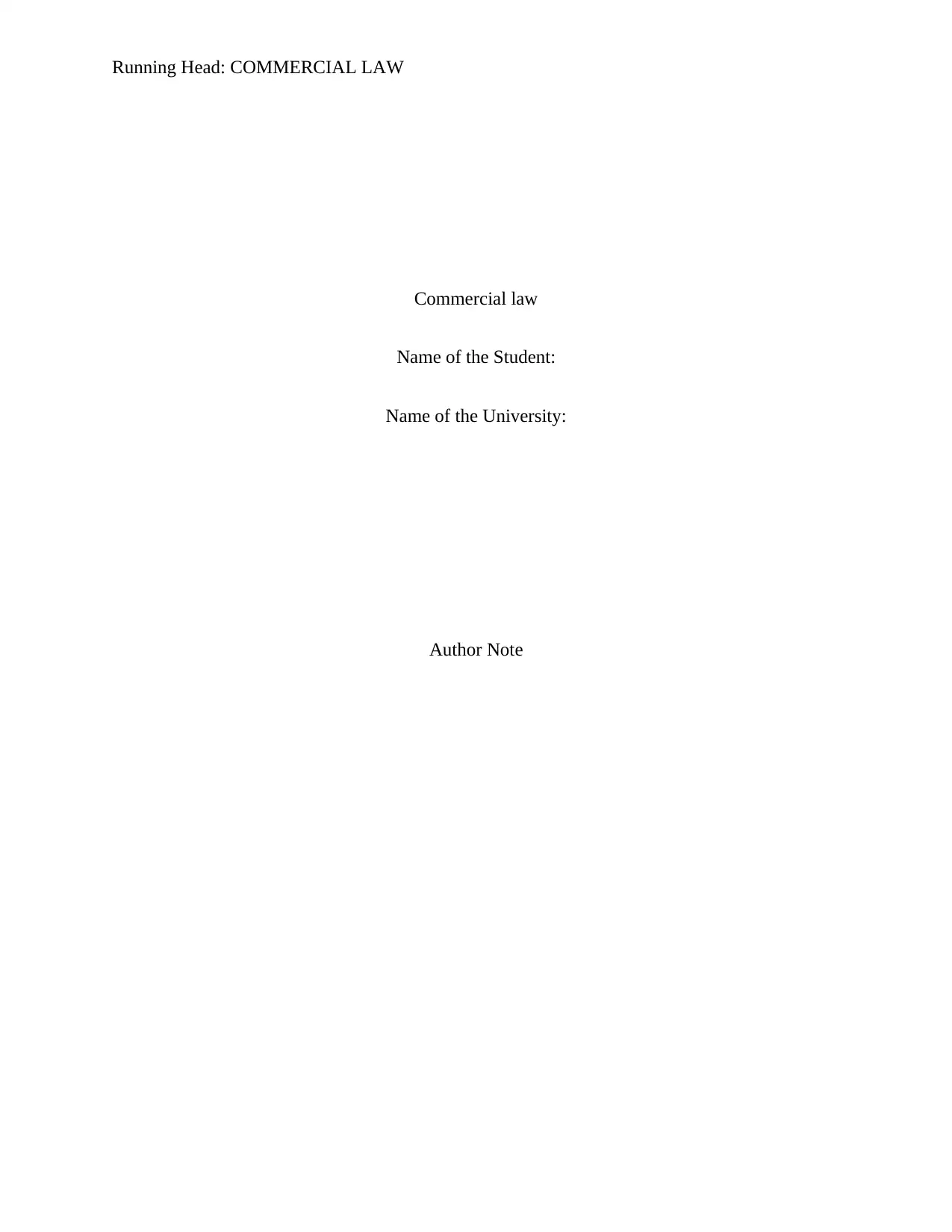
Running Head: COMMERCIAL LAW
Commercial law
Name of the Student:
Name of the University:
Author Note
Commercial law
Name of the Student:
Name of the University:
Author Note
Paraphrase This Document
Need a fresh take? Get an instant paraphrase of this document with our AI Paraphraser
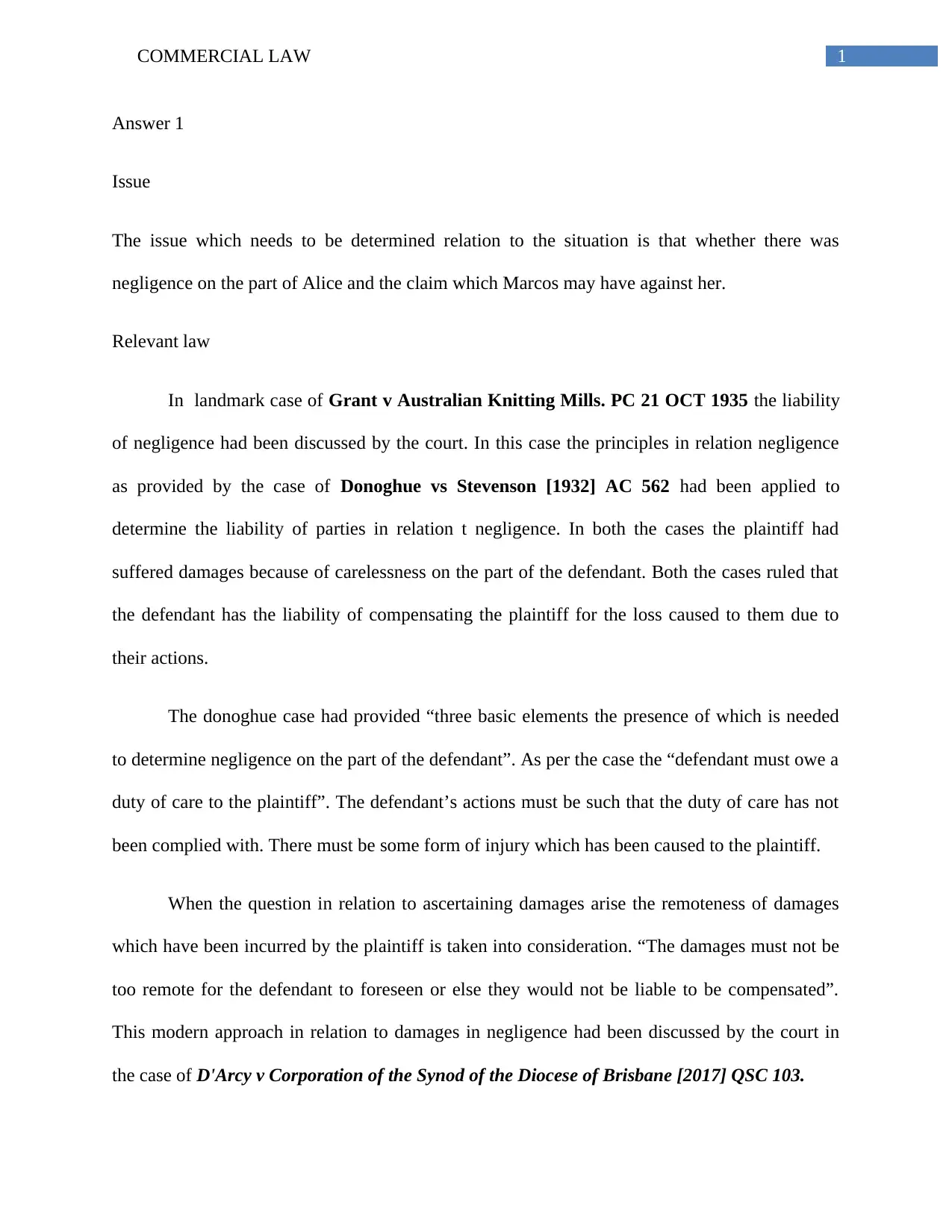
1COMMERCIAL LAW
Answer 1
Issue
The issue which needs to be determined relation to the situation is that whether there was
negligence on the part of Alice and the claim which Marcos may have against her.
Relevant law
In landmark case of Grant v Australian Knitting Mills. PC 21 OCT 1935 the liability
of negligence had been discussed by the court. In this case the principles in relation negligence
as provided by the case of Donoghue vs Stevenson [1932] AC 562 had been applied to
determine the liability of parties in relation t negligence. In both the cases the plaintiff had
suffered damages because of carelessness on the part of the defendant. Both the cases ruled that
the defendant has the liability of compensating the plaintiff for the loss caused to them due to
their actions.
The donoghue case had provided “three basic elements the presence of which is needed
to determine negligence on the part of the defendant”. As per the case the “defendant must owe a
duty of care to the plaintiff”. The defendant’s actions must be such that the duty of care has not
been complied with. There must be some form of injury which has been caused to the plaintiff.
When the question in relation to ascertaining damages arise the remoteness of damages
which have been incurred by the plaintiff is taken into consideration. “The damages must not be
too remote for the defendant to foreseen or else they would not be liable to be compensated”.
This modern approach in relation to damages in negligence had been discussed by the court in
the case of D'Arcy v Corporation of the Synod of the Diocese of Brisbane [2017] QSC 103.
Answer 1
Issue
The issue which needs to be determined relation to the situation is that whether there was
negligence on the part of Alice and the claim which Marcos may have against her.
Relevant law
In landmark case of Grant v Australian Knitting Mills. PC 21 OCT 1935 the liability
of negligence had been discussed by the court. In this case the principles in relation negligence
as provided by the case of Donoghue vs Stevenson [1932] AC 562 had been applied to
determine the liability of parties in relation t negligence. In both the cases the plaintiff had
suffered damages because of carelessness on the part of the defendant. Both the cases ruled that
the defendant has the liability of compensating the plaintiff for the loss caused to them due to
their actions.
The donoghue case had provided “three basic elements the presence of which is needed
to determine negligence on the part of the defendant”. As per the case the “defendant must owe a
duty of care to the plaintiff”. The defendant’s actions must be such that the duty of care has not
been complied with. There must be some form of injury which has been caused to the plaintiff.
When the question in relation to ascertaining damages arise the remoteness of damages
which have been incurred by the plaintiff is taken into consideration. “The damages must not be
too remote for the defendant to foreseen or else they would not be liable to be compensated”.
This modern approach in relation to damages in negligence had been discussed by the court in
the case of D'Arcy v Corporation of the Synod of the Diocese of Brisbane [2017] QSC 103.
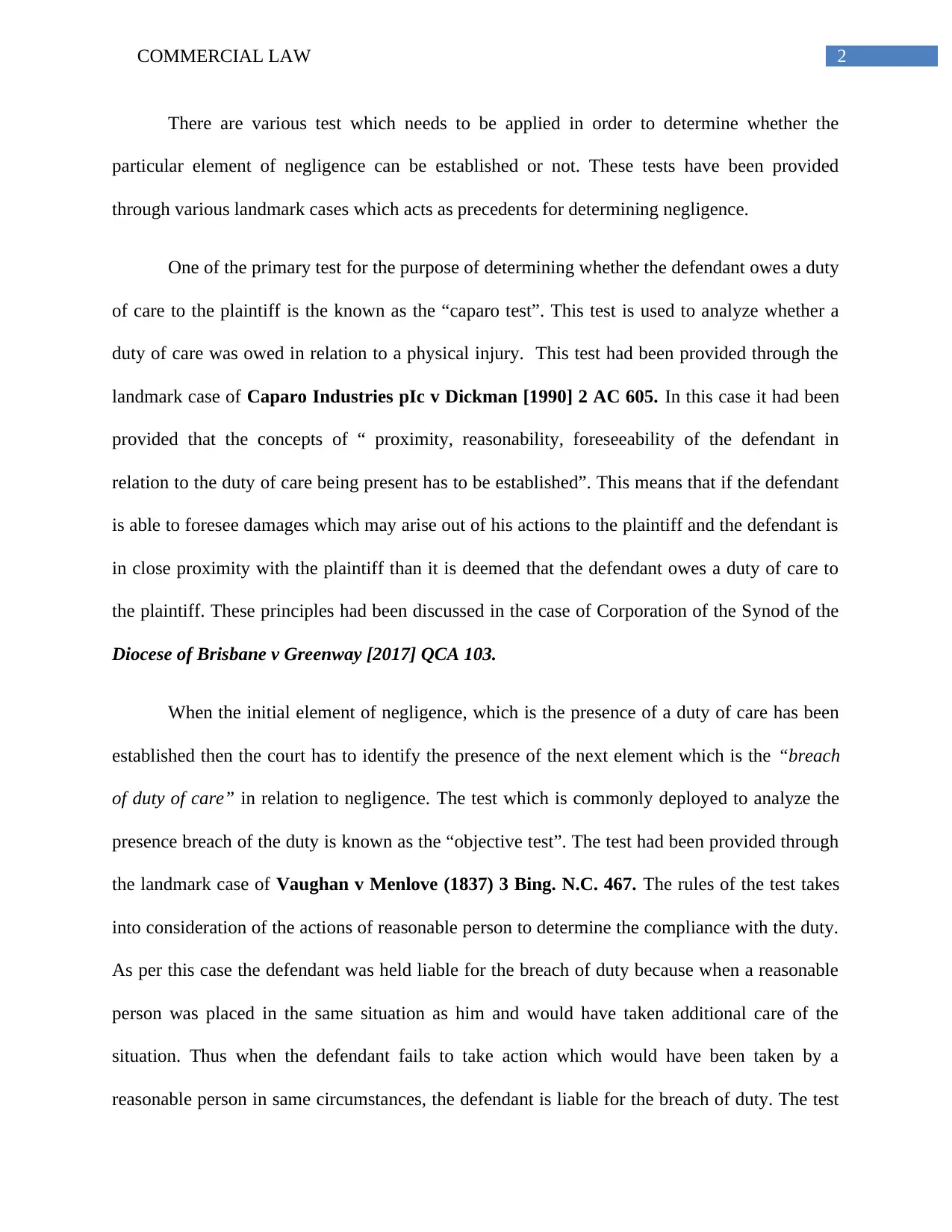
2COMMERCIAL LAW
There are various test which needs to be applied in order to determine whether the
particular element of negligence can be established or not. These tests have been provided
through various landmark cases which acts as precedents for determining negligence.
One of the primary test for the purpose of determining whether the defendant owes a duty
of care to the plaintiff is the known as the “caparo test”. This test is used to analyze whether a
duty of care was owed in relation to a physical injury. This test had been provided through the
landmark case of Caparo Industries pIc v Dickman [1990] 2 AC 605. In this case it had been
provided that the concepts of “ proximity, reasonability, foreseeability of the defendant in
relation to the duty of care being present has to be established”. This means that if the defendant
is able to foresee damages which may arise out of his actions to the plaintiff and the defendant is
in close proximity with the plaintiff than it is deemed that the defendant owes a duty of care to
the plaintiff. These principles had been discussed in the case of Corporation of the Synod of the
Diocese of Brisbane v Greenway [2017] QCA 103.
When the initial element of negligence, which is the presence of a duty of care has been
established then the court has to identify the presence of the next element which is the “breach
of duty of care” in relation to negligence. The test which is commonly deployed to analyze the
presence breach of the duty is known as the “objective test”. The test had been provided through
the landmark case of Vaughan v Menlove (1837) 3 Bing. N.C. 467. The rules of the test takes
into consideration of the actions of reasonable person to determine the compliance with the duty.
As per this case the defendant was held liable for the breach of duty because when a reasonable
person was placed in the same situation as him and would have taken additional care of the
situation. Thus when the defendant fails to take action which would have been taken by a
reasonable person in same circumstances, the defendant is liable for the breach of duty. The test
There are various test which needs to be applied in order to determine whether the
particular element of negligence can be established or not. These tests have been provided
through various landmark cases which acts as precedents for determining negligence.
One of the primary test for the purpose of determining whether the defendant owes a duty
of care to the plaintiff is the known as the “caparo test”. This test is used to analyze whether a
duty of care was owed in relation to a physical injury. This test had been provided through the
landmark case of Caparo Industries pIc v Dickman [1990] 2 AC 605. In this case it had been
provided that the concepts of “ proximity, reasonability, foreseeability of the defendant in
relation to the duty of care being present has to be established”. This means that if the defendant
is able to foresee damages which may arise out of his actions to the plaintiff and the defendant is
in close proximity with the plaintiff than it is deemed that the defendant owes a duty of care to
the plaintiff. These principles had been discussed in the case of Corporation of the Synod of the
Diocese of Brisbane v Greenway [2017] QCA 103.
When the initial element of negligence, which is the presence of a duty of care has been
established then the court has to identify the presence of the next element which is the “breach
of duty of care” in relation to negligence. The test which is commonly deployed to analyze the
presence breach of the duty is known as the “objective test”. The test had been provided through
the landmark case of Vaughan v Menlove (1837) 3 Bing. N.C. 467. The rules of the test takes
into consideration of the actions of reasonable person to determine the compliance with the duty.
As per this case the defendant was held liable for the breach of duty because when a reasonable
person was placed in the same situation as him and would have taken additional care of the
situation. Thus when the defendant fails to take action which would have been taken by a
reasonable person in same circumstances, the defendant is liable for the breach of duty. The test
⊘ This is a preview!⊘
Do you want full access?
Subscribe today to unlock all pages.

Trusted by 1+ million students worldwide
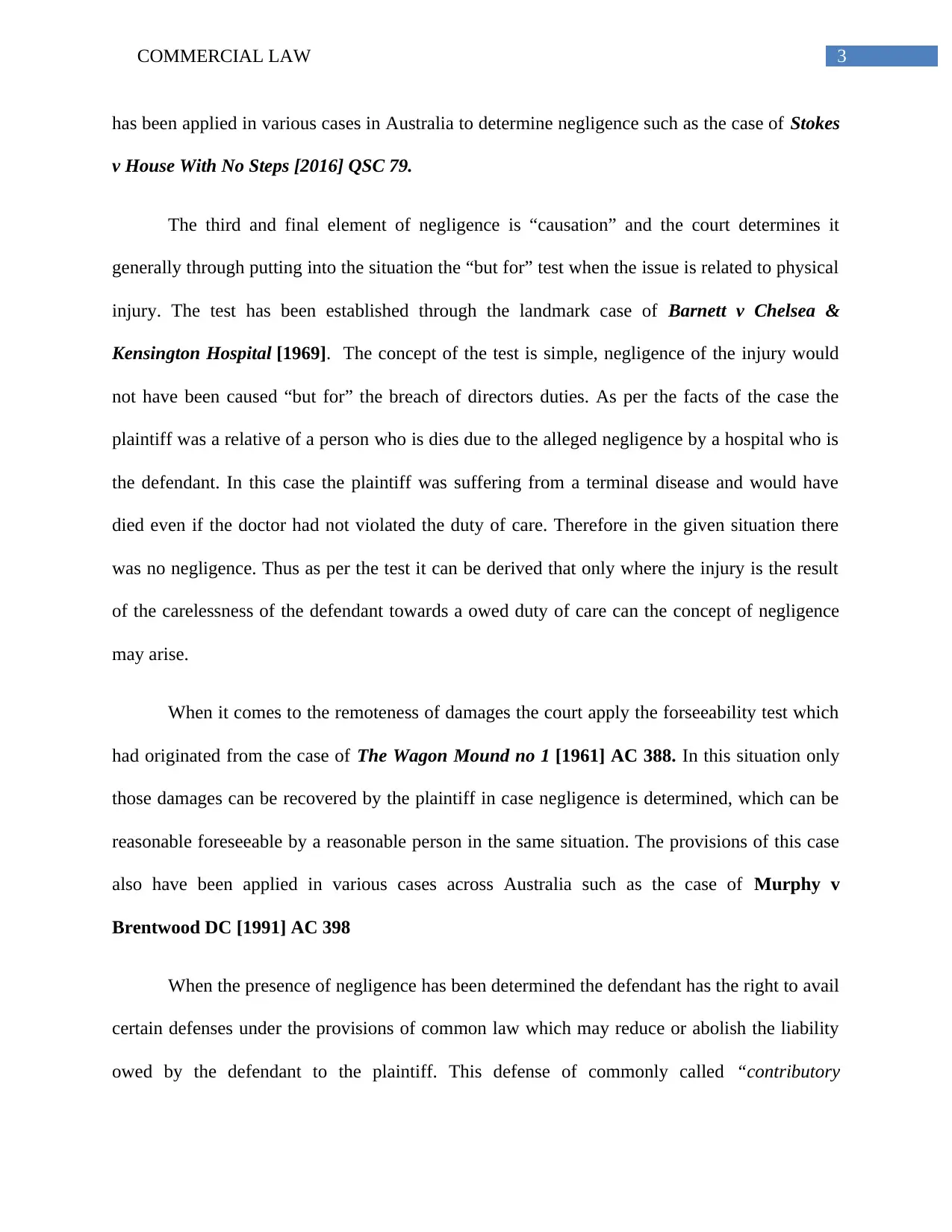
3COMMERCIAL LAW
has been applied in various cases in Australia to determine negligence such as the case of Stokes
v House With No Steps [2016] QSC 79.
The third and final element of negligence is “causation” and the court determines it
generally through putting into the situation the “but for” test when the issue is related to physical
injury. The test has been established through the landmark case of Barnett v Chelsea &
Kensington Hospital [1969]. The concept of the test is simple, negligence of the injury would
not have been caused “but for” the breach of directors duties. As per the facts of the case the
plaintiff was a relative of a person who is dies due to the alleged negligence by a hospital who is
the defendant. In this case the plaintiff was suffering from a terminal disease and would have
died even if the doctor had not violated the duty of care. Therefore in the given situation there
was no negligence. Thus as per the test it can be derived that only where the injury is the result
of the carelessness of the defendant towards a owed duty of care can the concept of negligence
may arise.
When it comes to the remoteness of damages the court apply the forseeability test which
had originated from the case of The Wagon Mound no 1 [1961] AC 388. In this situation only
those damages can be recovered by the plaintiff in case negligence is determined, which can be
reasonable foreseeable by a reasonable person in the same situation. The provisions of this case
also have been applied in various cases across Australia such as the case of Murphy v
Brentwood DC [1991] AC 398
When the presence of negligence has been determined the defendant has the right to avail
certain defenses under the provisions of common law which may reduce or abolish the liability
owed by the defendant to the plaintiff. This defense of commonly called “contributory
has been applied in various cases in Australia to determine negligence such as the case of Stokes
v House With No Steps [2016] QSC 79.
The third and final element of negligence is “causation” and the court determines it
generally through putting into the situation the “but for” test when the issue is related to physical
injury. The test has been established through the landmark case of Barnett v Chelsea &
Kensington Hospital [1969]. The concept of the test is simple, negligence of the injury would
not have been caused “but for” the breach of directors duties. As per the facts of the case the
plaintiff was a relative of a person who is dies due to the alleged negligence by a hospital who is
the defendant. In this case the plaintiff was suffering from a terminal disease and would have
died even if the doctor had not violated the duty of care. Therefore in the given situation there
was no negligence. Thus as per the test it can be derived that only where the injury is the result
of the carelessness of the defendant towards a owed duty of care can the concept of negligence
may arise.
When it comes to the remoteness of damages the court apply the forseeability test which
had originated from the case of The Wagon Mound no 1 [1961] AC 388. In this situation only
those damages can be recovered by the plaintiff in case negligence is determined, which can be
reasonable foreseeable by a reasonable person in the same situation. The provisions of this case
also have been applied in various cases across Australia such as the case of Murphy v
Brentwood DC [1991] AC 398
When the presence of negligence has been determined the defendant has the right to avail
certain defenses under the provisions of common law which may reduce or abolish the liability
owed by the defendant to the plaintiff. This defense of commonly called “contributory
Paraphrase This Document
Need a fresh take? Get an instant paraphrase of this document with our AI Paraphraser
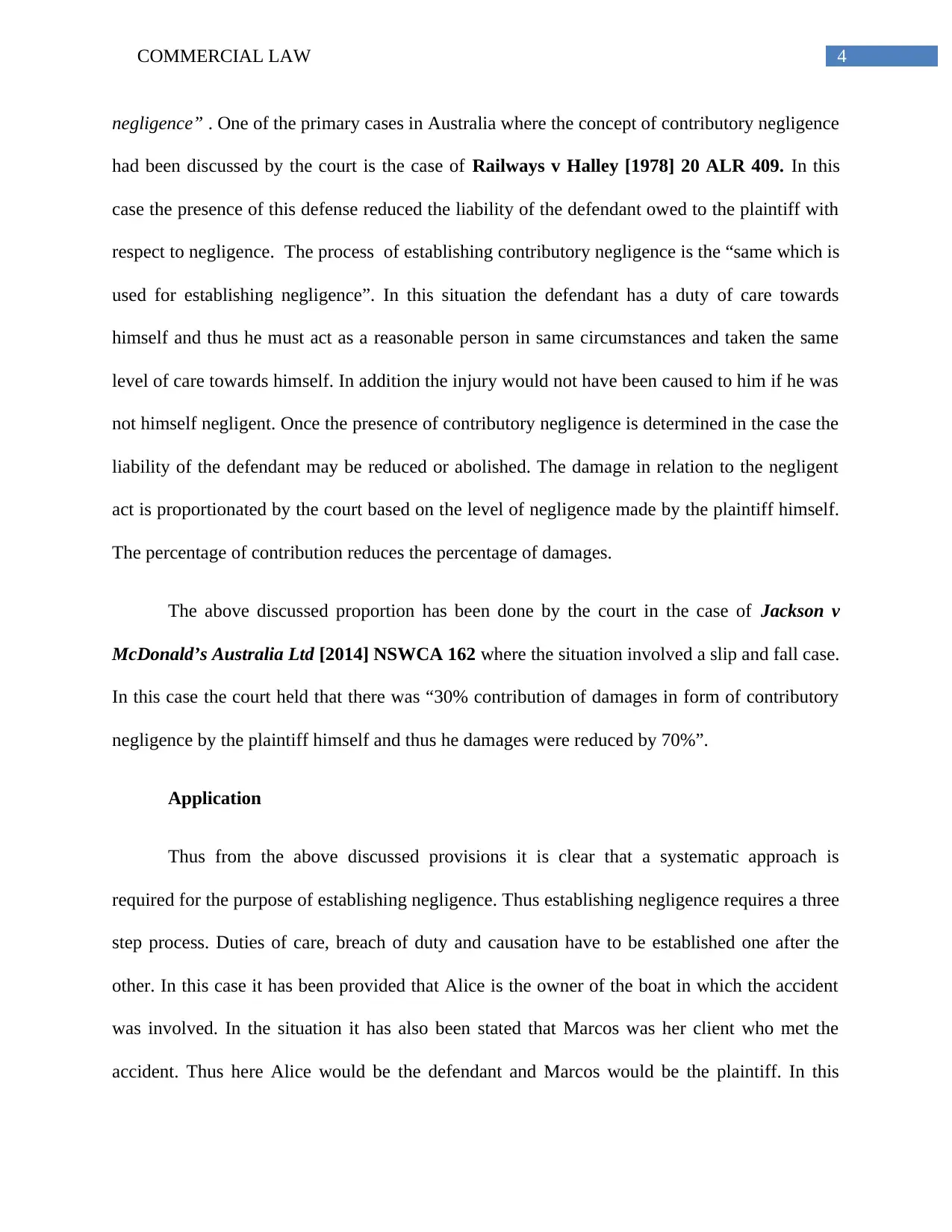
4COMMERCIAL LAW
negligence” . One of the primary cases in Australia where the concept of contributory negligence
had been discussed by the court is the case of Railways v Halley [1978] 20 ALR 409. In this
case the presence of this defense reduced the liability of the defendant owed to the plaintiff with
respect to negligence. The process of establishing contributory negligence is the “same which is
used for establishing negligence”. In this situation the defendant has a duty of care towards
himself and thus he must act as a reasonable person in same circumstances and taken the same
level of care towards himself. In addition the injury would not have been caused to him if he was
not himself negligent. Once the presence of contributory negligence is determined in the case the
liability of the defendant may be reduced or abolished. The damage in relation to the negligent
act is proportionated by the court based on the level of negligence made by the plaintiff himself.
The percentage of contribution reduces the percentage of damages.
The above discussed proportion has been done by the court in the case of Jackson v
McDonald’s Australia Ltd [2014] NSWCA 162 where the situation involved a slip and fall case.
In this case the court held that there was “30% contribution of damages in form of contributory
negligence by the plaintiff himself and thus he damages were reduced by 70%”.
Application
Thus from the above discussed provisions it is clear that a systematic approach is
required for the purpose of establishing negligence. Thus establishing negligence requires a three
step process. Duties of care, breach of duty and causation have to be established one after the
other. In this case it has been provided that Alice is the owner of the boat in which the accident
was involved. In the situation it has also been stated that Marcos was her client who met the
accident. Thus here Alice would be the defendant and Marcos would be the plaintiff. In this
negligence” . One of the primary cases in Australia where the concept of contributory negligence
had been discussed by the court is the case of Railways v Halley [1978] 20 ALR 409. In this
case the presence of this defense reduced the liability of the defendant owed to the plaintiff with
respect to negligence. The process of establishing contributory negligence is the “same which is
used for establishing negligence”. In this situation the defendant has a duty of care towards
himself and thus he must act as a reasonable person in same circumstances and taken the same
level of care towards himself. In addition the injury would not have been caused to him if he was
not himself negligent. Once the presence of contributory negligence is determined in the case the
liability of the defendant may be reduced or abolished. The damage in relation to the negligent
act is proportionated by the court based on the level of negligence made by the plaintiff himself.
The percentage of contribution reduces the percentage of damages.
The above discussed proportion has been done by the court in the case of Jackson v
McDonald’s Australia Ltd [2014] NSWCA 162 where the situation involved a slip and fall case.
In this case the court held that there was “30% contribution of damages in form of contributory
negligence by the plaintiff himself and thus he damages were reduced by 70%”.
Application
Thus from the above discussed provisions it is clear that a systematic approach is
required for the purpose of establishing negligence. Thus establishing negligence requires a three
step process. Duties of care, breach of duty and causation have to be established one after the
other. In this case it has been provided that Alice is the owner of the boat in which the accident
was involved. In the situation it has also been stated that Marcos was her client who met the
accident. Thus here Alice would be the defendant and Marcos would be the plaintiff. In this
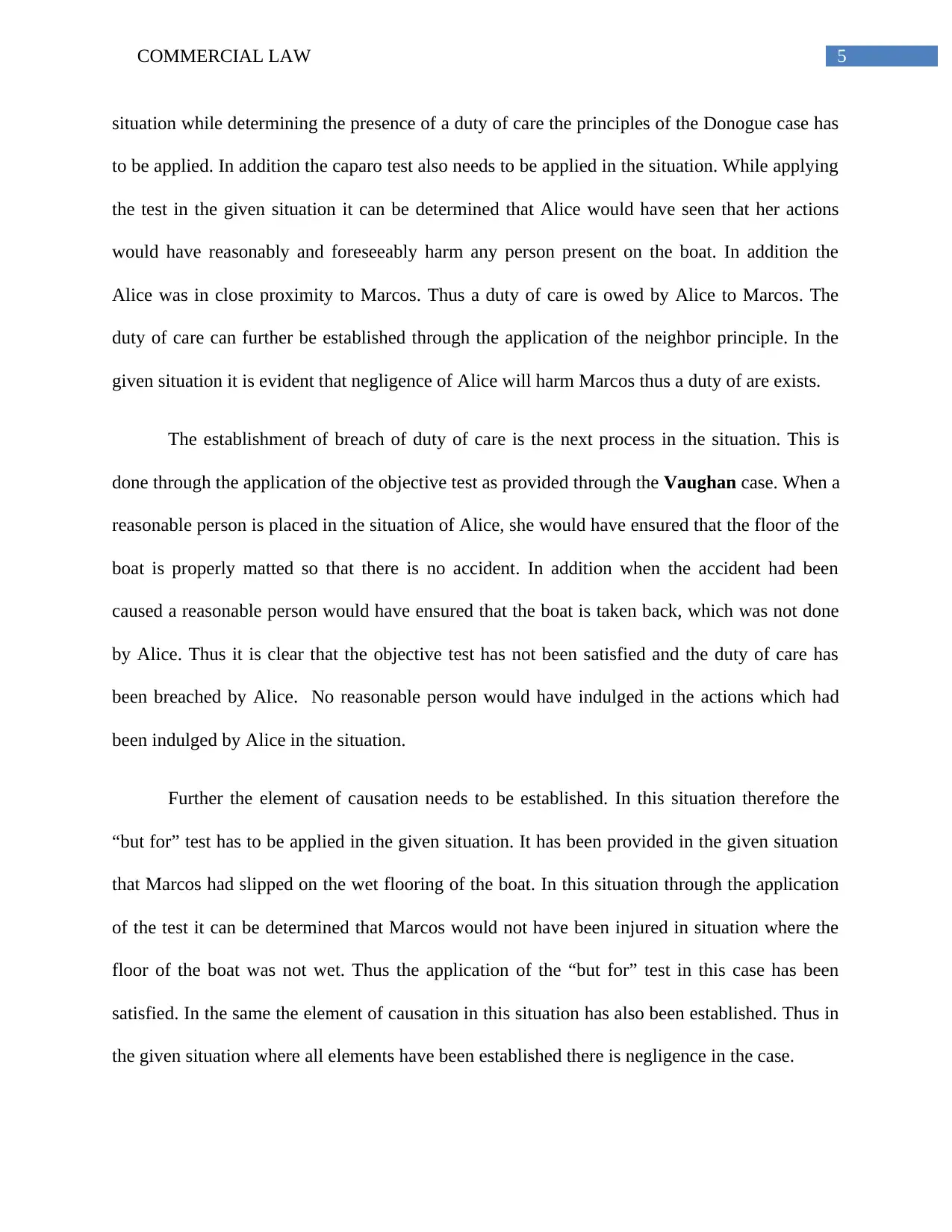
5COMMERCIAL LAW
situation while determining the presence of a duty of care the principles of the Donogue case has
to be applied. In addition the caparo test also needs to be applied in the situation. While applying
the test in the given situation it can be determined that Alice would have seen that her actions
would have reasonably and foreseeably harm any person present on the boat. In addition the
Alice was in close proximity to Marcos. Thus a duty of care is owed by Alice to Marcos. The
duty of care can further be established through the application of the neighbor principle. In the
given situation it is evident that negligence of Alice will harm Marcos thus a duty of are exists.
The establishment of breach of duty of care is the next process in the situation. This is
done through the application of the objective test as provided through the Vaughan case. When a
reasonable person is placed in the situation of Alice, she would have ensured that the floor of the
boat is properly matted so that there is no accident. In addition when the accident had been
caused a reasonable person would have ensured that the boat is taken back, which was not done
by Alice. Thus it is clear that the objective test has not been satisfied and the duty of care has
been breached by Alice. No reasonable person would have indulged in the actions which had
been indulged by Alice in the situation.
Further the element of causation needs to be established. In this situation therefore the
“but for” test has to be applied in the given situation. It has been provided in the given situation
that Marcos had slipped on the wet flooring of the boat. In this situation through the application
of the test it can be determined that Marcos would not have been injured in situation where the
floor of the boat was not wet. Thus the application of the “but for” test in this case has been
satisfied. In the same the element of causation in this situation has also been established. Thus in
the given situation where all elements have been established there is negligence in the case.
situation while determining the presence of a duty of care the principles of the Donogue case has
to be applied. In addition the caparo test also needs to be applied in the situation. While applying
the test in the given situation it can be determined that Alice would have seen that her actions
would have reasonably and foreseeably harm any person present on the boat. In addition the
Alice was in close proximity to Marcos. Thus a duty of care is owed by Alice to Marcos. The
duty of care can further be established through the application of the neighbor principle. In the
given situation it is evident that negligence of Alice will harm Marcos thus a duty of are exists.
The establishment of breach of duty of care is the next process in the situation. This is
done through the application of the objective test as provided through the Vaughan case. When a
reasonable person is placed in the situation of Alice, she would have ensured that the floor of the
boat is properly matted so that there is no accident. In addition when the accident had been
caused a reasonable person would have ensured that the boat is taken back, which was not done
by Alice. Thus it is clear that the objective test has not been satisfied and the duty of care has
been breached by Alice. No reasonable person would have indulged in the actions which had
been indulged by Alice in the situation.
Further the element of causation needs to be established. In this situation therefore the
“but for” test has to be applied in the given situation. It has been provided in the given situation
that Marcos had slipped on the wet flooring of the boat. In this situation through the application
of the test it can be determined that Marcos would not have been injured in situation where the
floor of the boat was not wet. Thus the application of the “but for” test in this case has been
satisfied. In the same the element of causation in this situation has also been established. Thus in
the given situation where all elements have been established there is negligence in the case.
⊘ This is a preview!⊘
Do you want full access?
Subscribe today to unlock all pages.

Trusted by 1+ million students worldwide
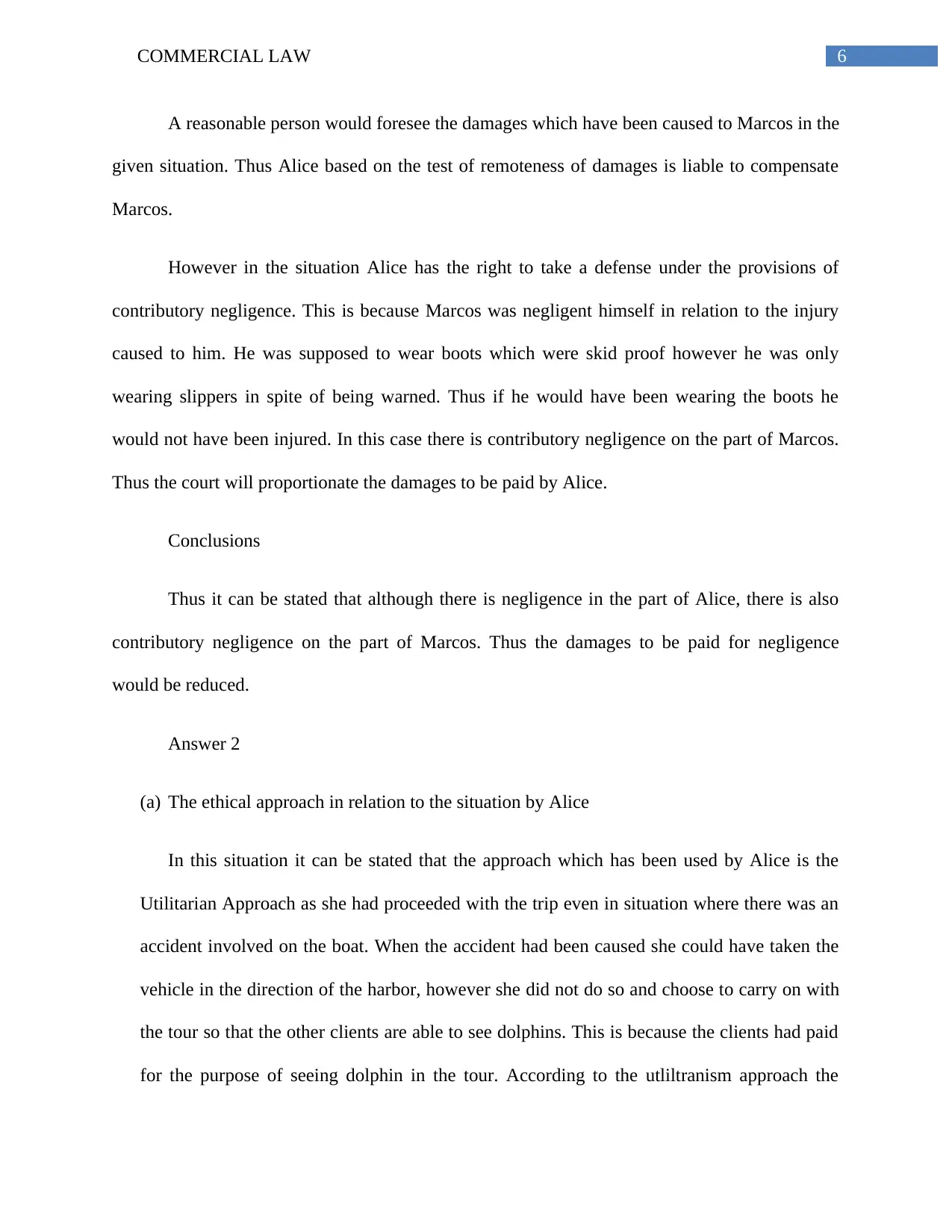
6COMMERCIAL LAW
A reasonable person would foresee the damages which have been caused to Marcos in the
given situation. Thus Alice based on the test of remoteness of damages is liable to compensate
Marcos.
However in the situation Alice has the right to take a defense under the provisions of
contributory negligence. This is because Marcos was negligent himself in relation to the injury
caused to him. He was supposed to wear boots which were skid proof however he was only
wearing slippers in spite of being warned. Thus if he would have been wearing the boots he
would not have been injured. In this case there is contributory negligence on the part of Marcos.
Thus the court will proportionate the damages to be paid by Alice.
Conclusions
Thus it can be stated that although there is negligence in the part of Alice, there is also
contributory negligence on the part of Marcos. Thus the damages to be paid for negligence
would be reduced.
Answer 2
(a) The ethical approach in relation to the situation by Alice
In this situation it can be stated that the approach which has been used by Alice is the
Utilitarian Approach as she had proceeded with the trip even in situation where there was an
accident involved on the boat. When the accident had been caused she could have taken the
vehicle in the direction of the harbor, however she did not do so and choose to carry on with
the tour so that the other clients are able to see dolphins. This is because the clients had paid
for the purpose of seeing dolphin in the tour. According to the utliltranism approach the
A reasonable person would foresee the damages which have been caused to Marcos in the
given situation. Thus Alice based on the test of remoteness of damages is liable to compensate
Marcos.
However in the situation Alice has the right to take a defense under the provisions of
contributory negligence. This is because Marcos was negligent himself in relation to the injury
caused to him. He was supposed to wear boots which were skid proof however he was only
wearing slippers in spite of being warned. Thus if he would have been wearing the boots he
would not have been injured. In this case there is contributory negligence on the part of Marcos.
Thus the court will proportionate the damages to be paid by Alice.
Conclusions
Thus it can be stated that although there is negligence in the part of Alice, there is also
contributory negligence on the part of Marcos. Thus the damages to be paid for negligence
would be reduced.
Answer 2
(a) The ethical approach in relation to the situation by Alice
In this situation it can be stated that the approach which has been used by Alice is the
Utilitarian Approach as she had proceeded with the trip even in situation where there was an
accident involved on the boat. When the accident had been caused she could have taken the
vehicle in the direction of the harbor, however she did not do so and choose to carry on with
the tour so that the other clients are able to see dolphins. This is because the clients had paid
for the purpose of seeing dolphin in the tour. According to the utliltranism approach the
Paraphrase This Document
Need a fresh take? Get an instant paraphrase of this document with our AI Paraphraser
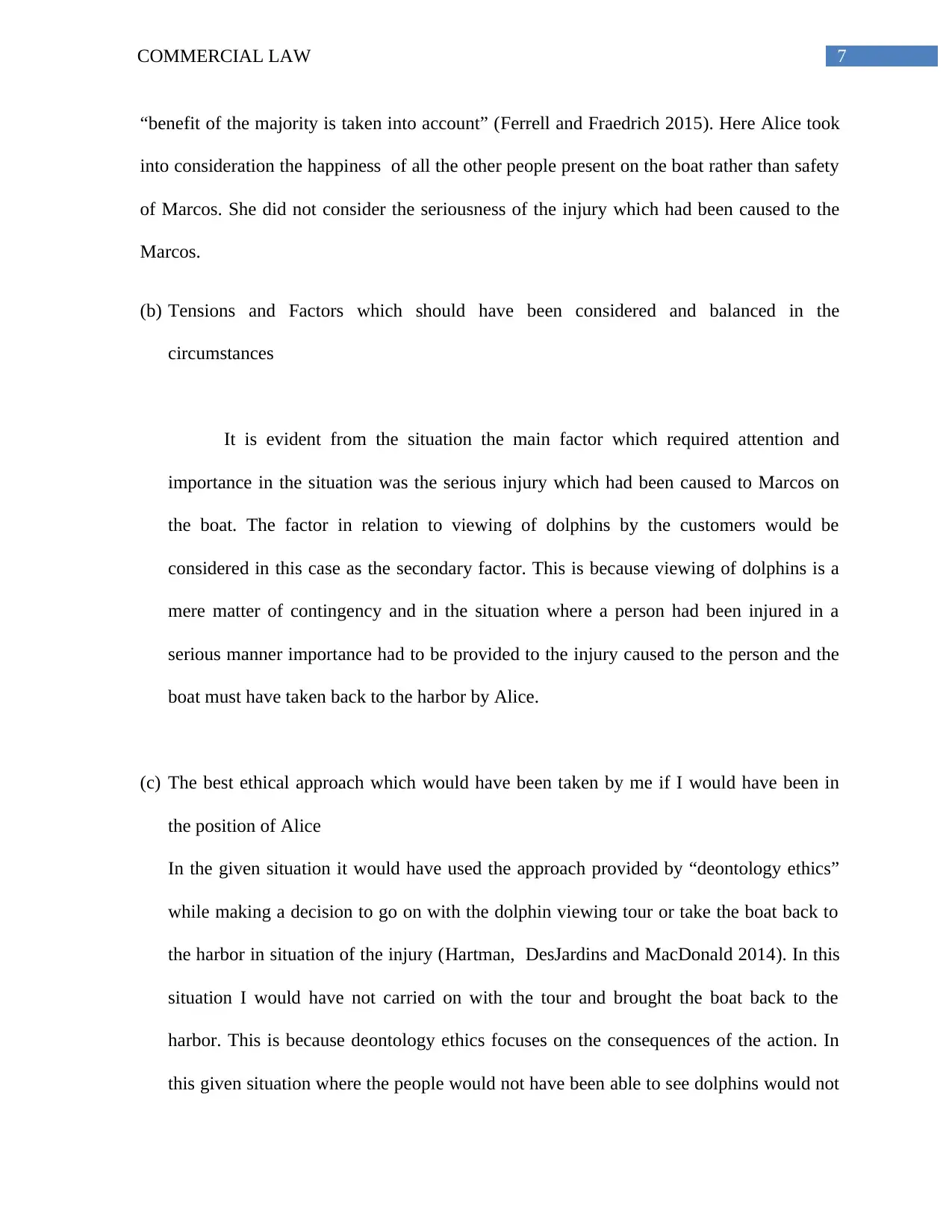
7COMMERCIAL LAW
“benefit of the majority is taken into account” (Ferrell and Fraedrich 2015). Here Alice took
into consideration the happiness of all the other people present on the boat rather than safety
of Marcos. She did not consider the seriousness of the injury which had been caused to the
Marcos.
(b) Tensions and Factors which should have been considered and balanced in the
circumstances
It is evident from the situation the main factor which required attention and
importance in the situation was the serious injury which had been caused to Marcos on
the boat. The factor in relation to viewing of dolphins by the customers would be
considered in this case as the secondary factor. This is because viewing of dolphins is a
mere matter of contingency and in the situation where a person had been injured in a
serious manner importance had to be provided to the injury caused to the person and the
boat must have taken back to the harbor by Alice.
(c) The best ethical approach which would have been taken by me if I would have been in
the position of Alice
In the given situation it would have used the approach provided by “deontology ethics”
while making a decision to go on with the dolphin viewing tour or take the boat back to
the harbor in situation of the injury (Hartman, DesJardins and MacDonald 2014). In this
situation I would have not carried on with the tour and brought the boat back to the
harbor. This is because deontology ethics focuses on the consequences of the action. In
this given situation where the people would not have been able to see dolphins would not
“benefit of the majority is taken into account” (Ferrell and Fraedrich 2015). Here Alice took
into consideration the happiness of all the other people present on the boat rather than safety
of Marcos. She did not consider the seriousness of the injury which had been caused to the
Marcos.
(b) Tensions and Factors which should have been considered and balanced in the
circumstances
It is evident from the situation the main factor which required attention and
importance in the situation was the serious injury which had been caused to Marcos on
the boat. The factor in relation to viewing of dolphins by the customers would be
considered in this case as the secondary factor. This is because viewing of dolphins is a
mere matter of contingency and in the situation where a person had been injured in a
serious manner importance had to be provided to the injury caused to the person and the
boat must have taken back to the harbor by Alice.
(c) The best ethical approach which would have been taken by me if I would have been in
the position of Alice
In the given situation it would have used the approach provided by “deontology ethics”
while making a decision to go on with the dolphin viewing tour or take the boat back to
the harbor in situation of the injury (Hartman, DesJardins and MacDonald 2014). In this
situation I would have not carried on with the tour and brought the boat back to the
harbor. This is because deontology ethics focuses on the consequences of the action. In
this given situation where the people would not have been able to see dolphins would not
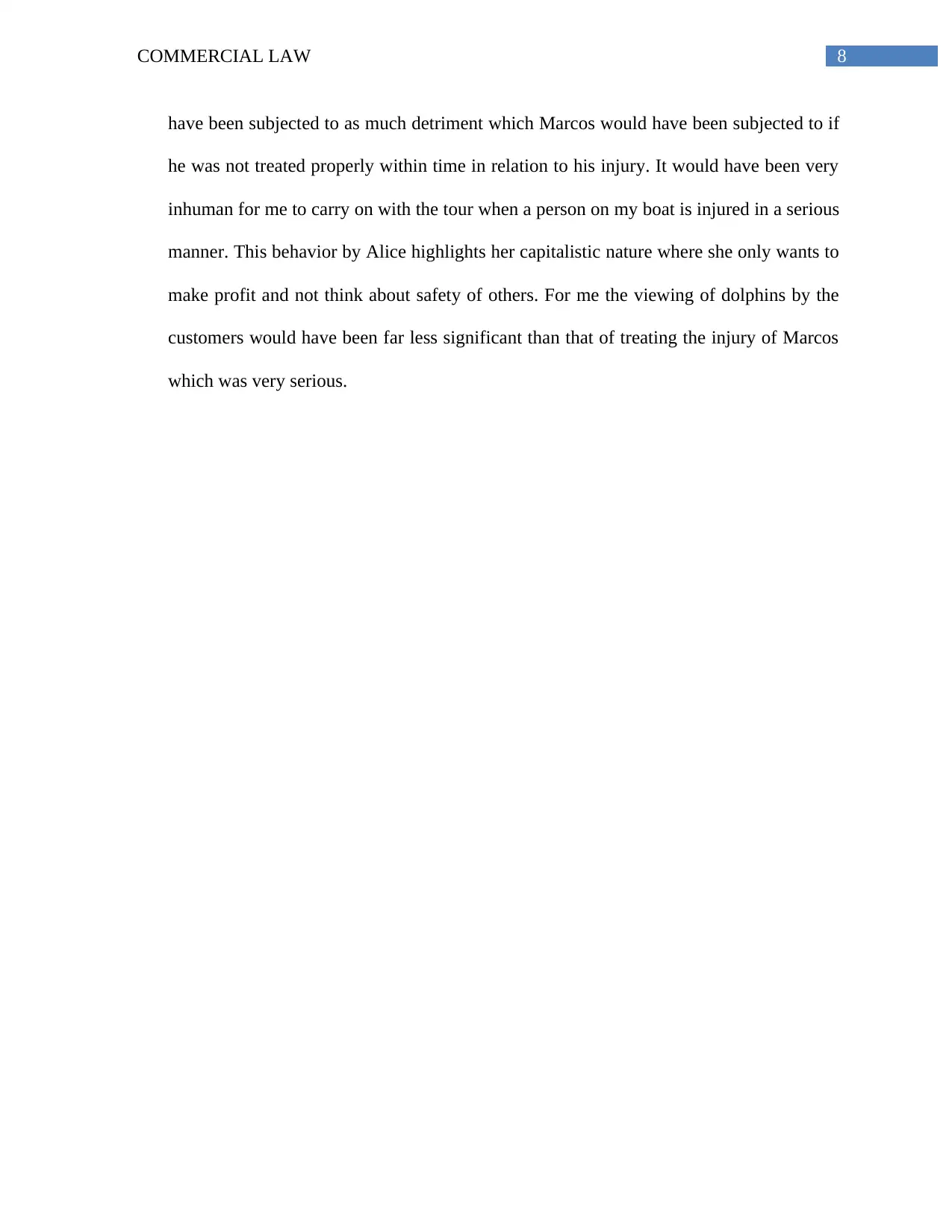
8COMMERCIAL LAW
have been subjected to as much detriment which Marcos would have been subjected to if
he was not treated properly within time in relation to his injury. It would have been very
inhuman for me to carry on with the tour when a person on my boat is injured in a serious
manner. This behavior by Alice highlights her capitalistic nature where she only wants to
make profit and not think about safety of others. For me the viewing of dolphins by the
customers would have been far less significant than that of treating the injury of Marcos
which was very serious.
have been subjected to as much detriment which Marcos would have been subjected to if
he was not treated properly within time in relation to his injury. It would have been very
inhuman for me to carry on with the tour when a person on my boat is injured in a serious
manner. This behavior by Alice highlights her capitalistic nature where she only wants to
make profit and not think about safety of others. For me the viewing of dolphins by the
customers would have been far less significant than that of treating the injury of Marcos
which was very serious.
⊘ This is a preview!⊘
Do you want full access?
Subscribe today to unlock all pages.

Trusted by 1+ million students worldwide
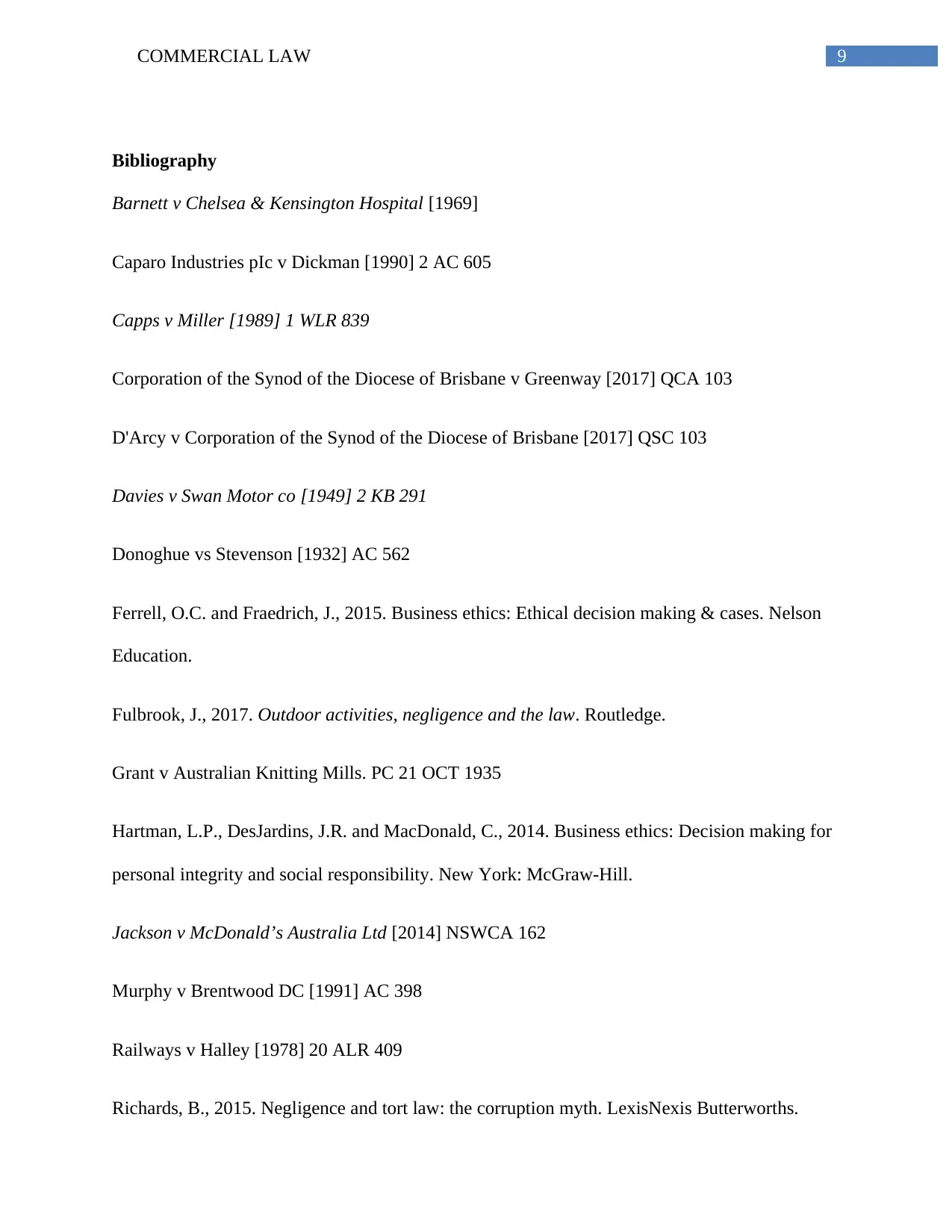
9COMMERCIAL LAW
Bibliography
Barnett v Chelsea & Kensington Hospital [1969]
Caparo Industries pIc v Dickman [1990] 2 AC 605
Capps v Miller [1989] 1 WLR 839
Corporation of the Synod of the Diocese of Brisbane v Greenway [2017] QCA 103
D'Arcy v Corporation of the Synod of the Diocese of Brisbane [2017] QSC 103
Davies v Swan Motor co [1949] 2 KB 291
Donoghue vs Stevenson [1932] AC 562
Ferrell, O.C. and Fraedrich, J., 2015. Business ethics: Ethical decision making & cases. Nelson
Education.
Fulbrook, J., 2017. Outdoor activities, negligence and the law. Routledge.
Grant v Australian Knitting Mills. PC 21 OCT 1935
Hartman, L.P., DesJardins, J.R. and MacDonald, C., 2014. Business ethics: Decision making for
personal integrity and social responsibility. New York: McGraw-Hill.
Jackson v McDonald’s Australia Ltd [2014] NSWCA 162
Murphy v Brentwood DC [1991] AC 398
Railways v Halley [1978] 20 ALR 409
Richards, B., 2015. Negligence and tort law: the corruption myth. LexisNexis Butterworths.
Bibliography
Barnett v Chelsea & Kensington Hospital [1969]
Caparo Industries pIc v Dickman [1990] 2 AC 605
Capps v Miller [1989] 1 WLR 839
Corporation of the Synod of the Diocese of Brisbane v Greenway [2017] QCA 103
D'Arcy v Corporation of the Synod of the Diocese of Brisbane [2017] QSC 103
Davies v Swan Motor co [1949] 2 KB 291
Donoghue vs Stevenson [1932] AC 562
Ferrell, O.C. and Fraedrich, J., 2015. Business ethics: Ethical decision making & cases. Nelson
Education.
Fulbrook, J., 2017. Outdoor activities, negligence and the law. Routledge.
Grant v Australian Knitting Mills. PC 21 OCT 1935
Hartman, L.P., DesJardins, J.R. and MacDonald, C., 2014. Business ethics: Decision making for
personal integrity and social responsibility. New York: McGraw-Hill.
Jackson v McDonald’s Australia Ltd [2014] NSWCA 162
Murphy v Brentwood DC [1991] AC 398
Railways v Halley [1978] 20 ALR 409
Richards, B., 2015. Negligence and tort law: the corruption myth. LexisNexis Butterworths.
Paraphrase This Document
Need a fresh take? Get an instant paraphrase of this document with our AI Paraphraser
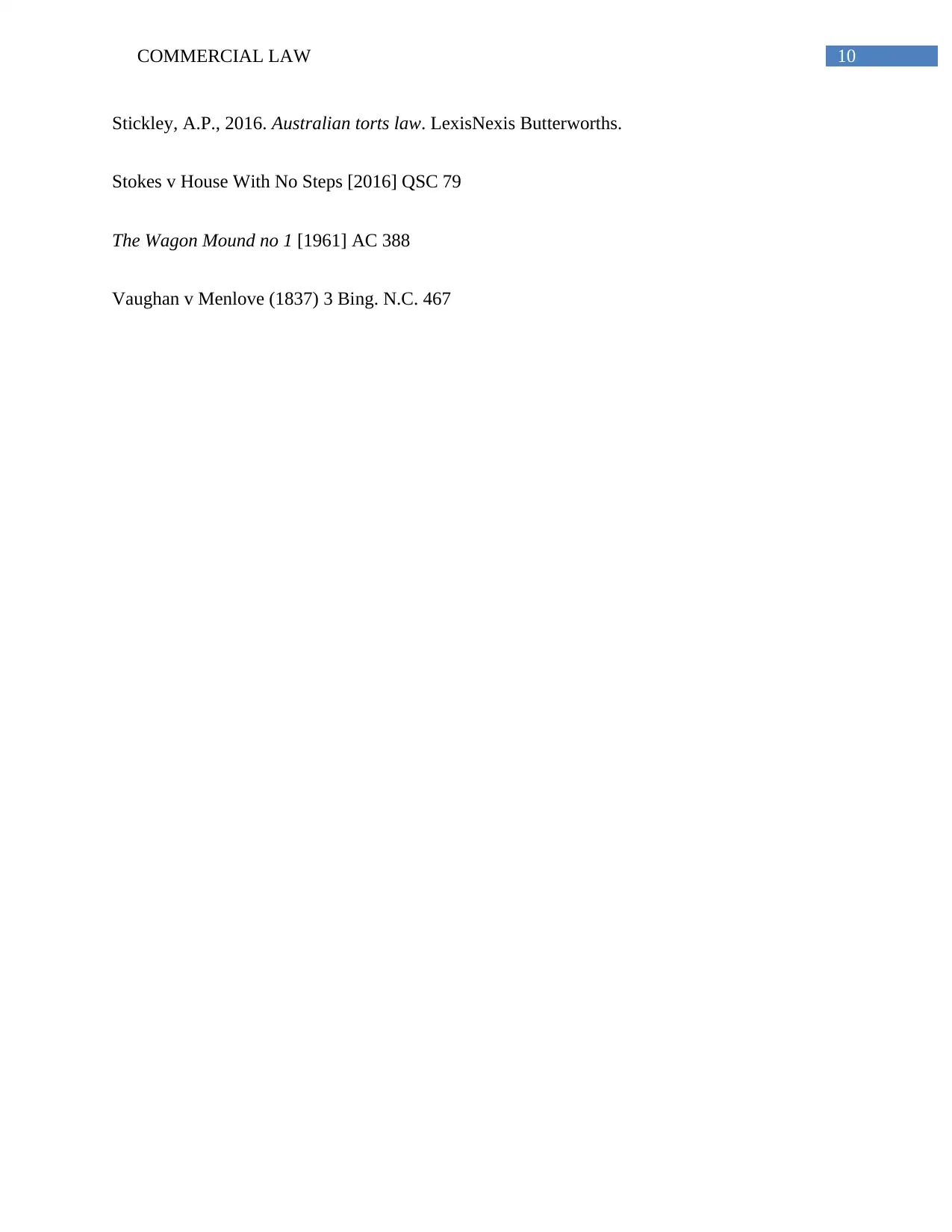
10COMMERCIAL LAW
Stickley, A.P., 2016. Australian torts law. LexisNexis Butterworths.
Stokes v House With No Steps [2016] QSC 79
The Wagon Mound no 1 [1961] AC 388
Vaughan v Menlove (1837) 3 Bing. N.C. 467
Stickley, A.P., 2016. Australian torts law. LexisNexis Butterworths.
Stokes v House With No Steps [2016] QSC 79
The Wagon Mound no 1 [1961] AC 388
Vaughan v Menlove (1837) 3 Bing. N.C. 467
1 out of 11
Related Documents
Your All-in-One AI-Powered Toolkit for Academic Success.
+13062052269
info@desklib.com
Available 24*7 on WhatsApp / Email
![[object Object]](/_next/static/media/star-bottom.7253800d.svg)
Unlock your academic potential
Copyright © 2020–2025 A2Z Services. All Rights Reserved. Developed and managed by ZUCOL.





